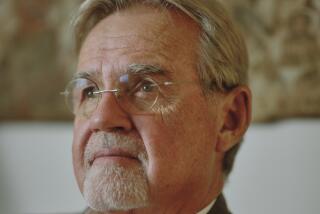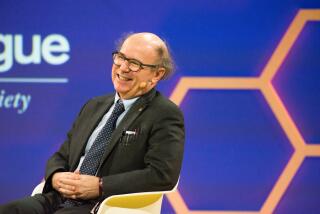Physicist to Test Relative Merits of Einstein’s Theory
- Share via
Some people retire into a life of crossword puzzles and golf. Some bury themselves in books, either reading or writing them. But Chalmers Sherwin has taken up a different hobby. He’s out in the garage attempting to prove that Albert Einstein was full of beans.
The 71-year-old Rancho Bernardo physicist has all the tools, mental and mechanical, to test Einstein’s special theory of relativity against a similar one developed independently by a less heralded scientist, Hendrick A. Lorentz, who used completely different hypotheses.
Both men came up with the same answer, but which one took the right theoretical path to reach the goal?
Sherwin, with a lifetime of academic, governmental and industrial credentials behind him, has spent six years in experimentation to answer that question. He is inclined to think that the Dutchman Lorentz was right and that mighty Einstein was wrong.
What puzzles Sherwin most, he says, is why, in the 83 years since Einstein published his most famous theory, no one has tried to test it.
One reason may be the sophisticated equipment needed to disprove it. Electronic equipment like the circuit boards that stud Sherwin’s test equipment, synthetic fibers, oscilloscopes and recording devices have only been around for the past few decades.
Answer May Be at Radio Shack
Now Sherwin can browse through myriad discount shops and surplus stores to find the parts to shape his Einstein-crusher.
Many’s the time her husband has returned home victorious, Irene Sherwin said, “blessing Radio Shack.”
Irene Sherwin turned to weaving and now to calligraphy to fill the time and space when her husband is in the garage wrestling with relativity.
In the Sherwins’ garage, the mass of his experimental materials has spread across two-thirds of the width, squeezing the couple’s 14-year-old Mercedes-Benz tightly against the wall. When the physicist begins his sensitive experimental testing, the Mercedes may be evicted. The opening and closing of the garage door could jar the delicate recording equipment.
In the simplest terms, Sherwin is trying to find a flaw in Einstein’s theorizing by actually testing it out. He certainly has the qualifications to do so. Sherwin received his Ph.D. in Physics at University of Chicago in 1940. From 1946 until 1960 he was professor of physics at the University of Illinois. From 1960 to 1963 he was vice president for laboratories at Aerospace Corp., after which he served for two years as a deputy director of defense and research engineering for the Department of Defense. Over the next decade he served in several positions in government and industry, including a long stint with General Atomics.
More recently, he has spent several thousand dollars and many more hours creating his testing apparatus, which resembles a giant ice cream churn but is actually a vacuum chamber in which Sherwin hopes to produce a glitch in Einstein’s time-space hypothesis.
Although both scientists’ theories of relativity predicted or explained the same experimental results, each embodied very different concepts of space and time, Sherwin said. For Lorentz, space and time were separate. For Einstein, space and time form a single, indivisible entity--a four-dimensional “spacetime.”
In his first test, Einstein won; Lorentz and Sherwin lost. Undaunted, Sherwin has set about to refine his equipment, making it 50 times more sensitive, in order to discover that one flaw in Einstein’s theory.
Some Think It’s Sacrilege
Sherwin says that many of his scientific colleagues regard his experimentation as sacrilege. But they should remember that other long-accepted laws of physics have been found to be flawed. A tiny flaw in Isaac Newton’s law of gravitation was discovered by astronomers and it was Einstein who stepped forth and made the small correction.
At a recent world affairs group meeting at which Sherwin spoke, several audience members walked out and others remained to heckle and criticize. One of his scientific friends admitted to Sherwin that he would not even bother to read a scientific article attacking Einstein’s special theory of relativity.
Sherwin accepts the negative vibes with equanimity.
“There are perhaps only a dozen or so physicists in the world who are willing to even contemplate the idea that Einstein might be wrong, much less make the effort to design and perform an experiment that can distinguish between the two theories,” Sherwin said.
“Physicists must deal with more than their share of crackpots,” Sherwin admits, but to reject any challenge to established theory is not the scientific way.
Einstein is a formidable opponent and the simplicity, even elegance, of his relativity theory is much more easily accepted than the clumsy, pedestrian reasoning of Lorentz, he said. But, where’s the proof that Einstein’s right and Lorentz is wrong?
So Sherwin continues his time-consuming pursuits in his garage laboratory, while his wife frowns at him for braving the unheated workroom while still recovering from pneumonia.
Even if he proves that Einstein’s hypotheses were flawed, he will not have proved Lorentz’s hypotheses right, Sherwin concedes. Theory can be challenged and found flawed through experimentation, but it cannot be proved to be correct. There may be another set of hypotheses, as yet unstated, to prove the special theory of relativity.
And what if he does find that Einstein was a bit off the track about time and space? Will the skies go dark? Will the earth crumble?
“No,” Sherwin said. “This will have no practical application, no effect. This is truly pure science.”






